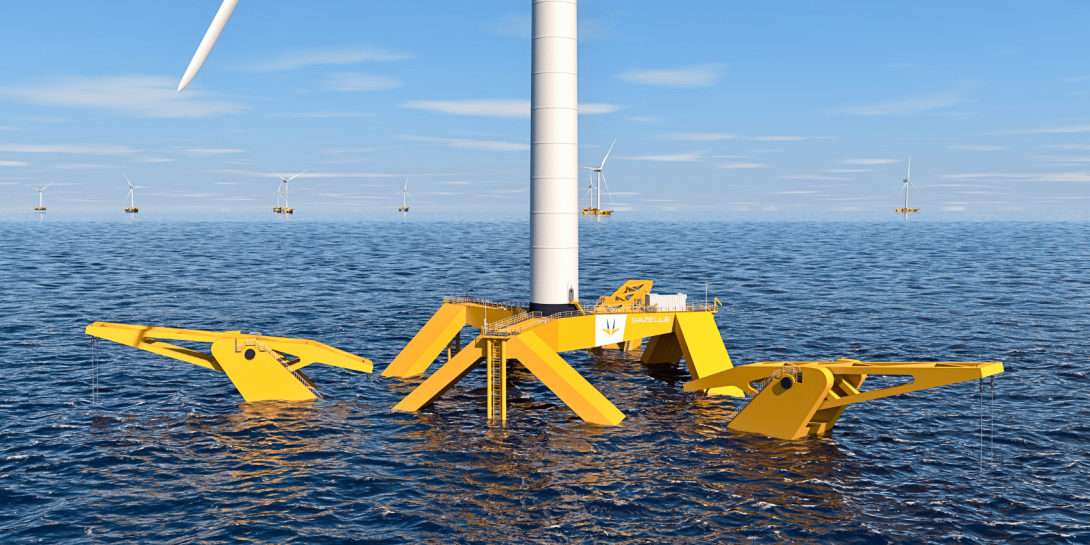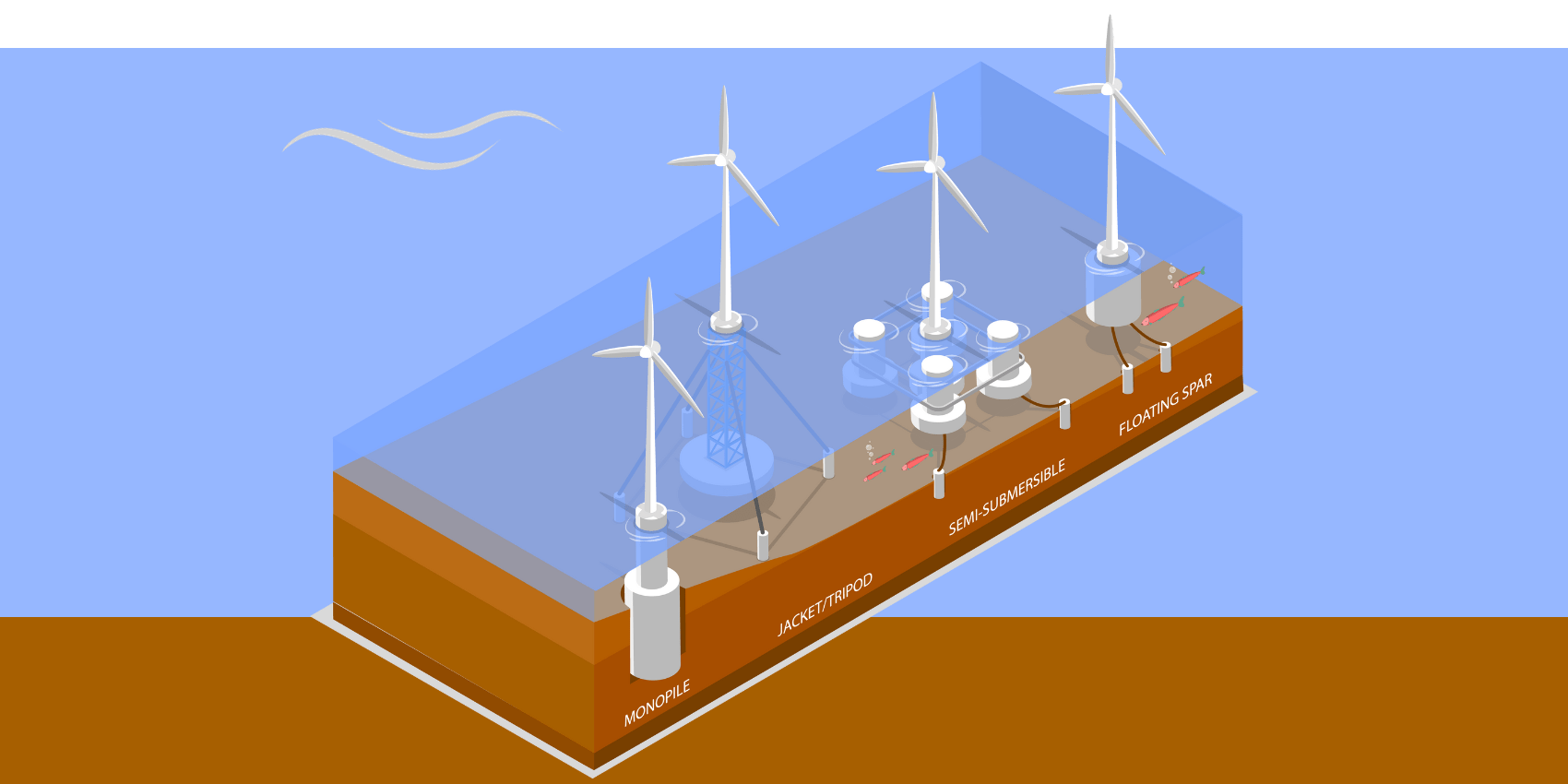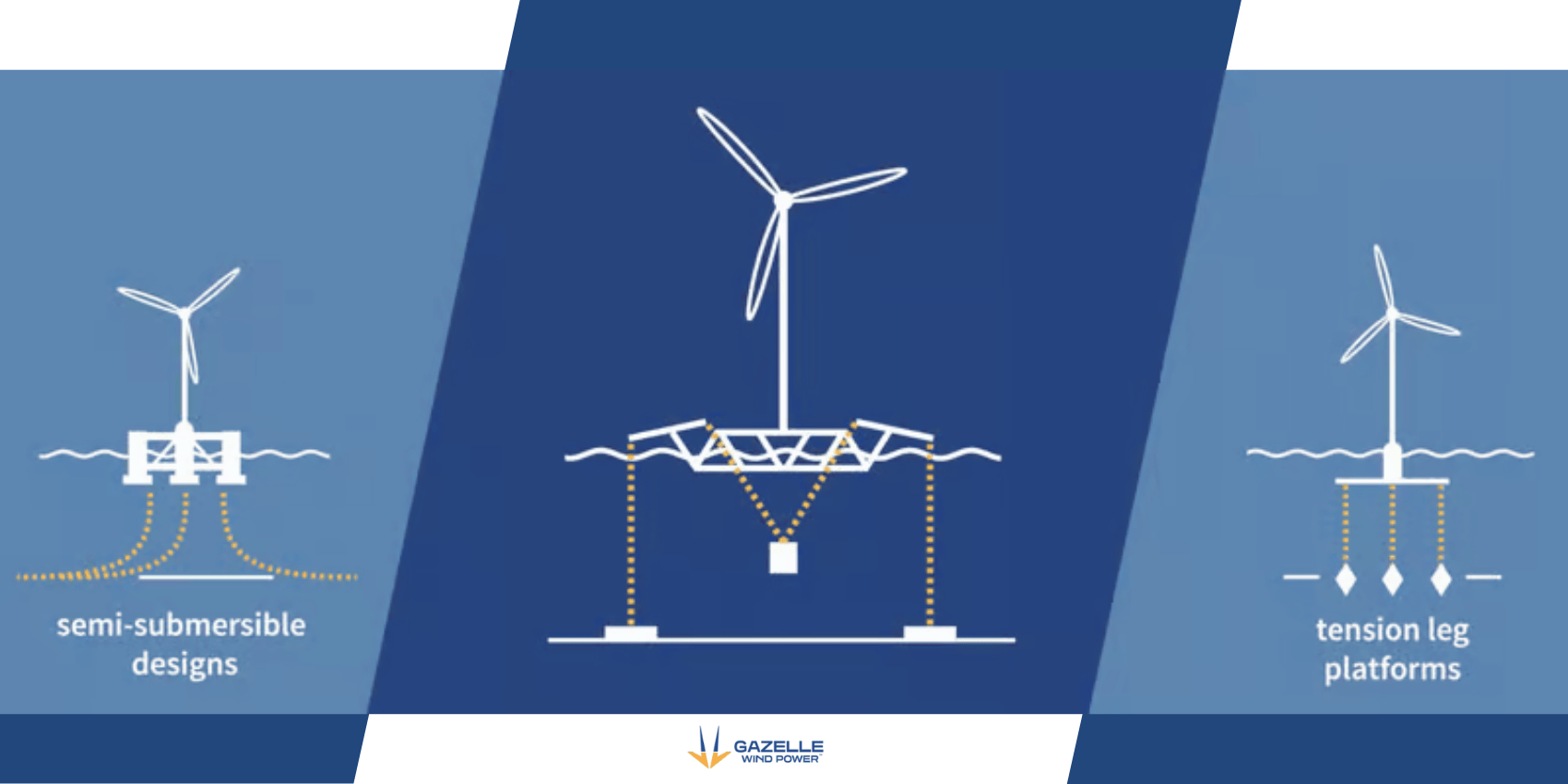

INTELLIGENT ENGINEERING
For a comprehensive insight into global offshore wind advancements, one need only examine the rapid and methodical progression observed in the UK. The shift from onshore to offshore wind projects represents a logical and strategic evolution in wind energy deployment. Evidently, the trajectory points towards the increasing prominence of floating wind technologies in the future landscape of renewable energy.
In the UK, electricity generated by wind power surged by 715% between 2009 and 2020, contributing to 24% of the total electricity in 2020—13% from offshore and 11% from onshore wind. Aiming for net-zero emissions by 2035, the UK has prioritised offshore wind, following the curtailment of onshore wind investment since 2015 due to aesthetic and noise concerns and the higher energy yield from larger offshore turbines.
Currently, the UK houses nearly 11,500 wind turbines, including 8,827 onshore and 2,652 offshore. The rapid progression in offshore wind energy is evident, with projects fully commissioned totalling a capacity of 13,660 and several others in various developmental stages, promising a future rich in sustainable energy solutions.

To achieve net-zero emissions, a third of the UK’s sea area, approximately 120,000 sq. km, with a water depth of less than 50 metres, would be necessary. Given area and planning restrictions and optimal wind conditions offshore, the focus has shifted to floating offshore wind development. The first large commercial installation in the UK has been commissioned, demonstrating productivity and cost-effectiveness over fixed foundation turbines. Floating turbines, positioned further offshore, potentially harvest twice the energy from the same rotor size due to stable winds and encounter fewer conflicts - visual and auditory disturbances.
Recognising the potential, the UK government is championing floating offshore wind technology, extending investment schemes to bolster capability across the UK, including Scotland and Wales. This support aims to instil confidence in private investors and stimulate sector growth, positioning the UK as a global leader in floating offshore wind, as outlined by the Department for Business, Energy and Industrial Strategy (BEIS).

What is floating offshore wind energy?
Floating wind turbines, unlike their fixed-bottom counterparts, don't require seabed anchoring, allowing placement in water depths exceeding 60 meters where winds are stronger. These turbines are secured to the seabed via multiple mooring lines. Floating offshore wind (FOW) represents a rapidly advancing technology poised to establish Europe's leadership in global renewable energy.
Types of floating platforms for wind turbines
Numerous companies worldwide have joined the race to optimise the safety, efficiency, variability, and maintainability of emerging floating technologies. The current sea-tested platforms fall into four categories:
- Spars, characterised by a single vertical cylinder with ballast at the base.
- Semi-submersibles, featuring three to five interconnected vertical cylinders with the turbine positioned at the centre or above one of the columns.
- Tension leg platforms, relying on taut mooring lines for stability.
- Barges, offering wide and shallow platforms.
The Importance of Accreditation in Innovation
Accreditation plays a pivotal role in affirming the viability and safety of innovative solutions in the wind energy domain. One such example is Gazelle Wind Power, which has obtained a Statement of Feasibility from DNV for its innovative hybrid floating wind platform featuring an integrated mobile mooring system.
Gazelle's innovative design combines the advantages of tension-leg and semi-submersible platforms while reducing many of their disadvantages. This platform enables wind farms to operate in deep waters, up to 400 meters offshore. It is notably lighter, using 70% less steel and weighing only one-third of other floating platforms. Gazelle's design also reduces horizontal movement by 70% compared to semi-submersible platforms, boasts less than 1° tilt, and diminishes mooring tension load by 80% compared to tension leg platforms. Its compact and straightforward construction and maintenance translate to significantly lower levelized cost of energy (LCOE).
As an independent reviewer, EPConsult Energies asserts that the technology developed by Gazelle Wind Power has the potential to represent the next generation of advancements crucial for the evolution of additional floating offshore wind farms, maintaining an objective standpoint on Gazelle's contribution to the field.

Potential of floating offshore wind
Although the UK presently generates sufficient offshore wind power to supply electricity to 7 million homes, only a fraction of this power comes from floating offshore wind. While fixed-bottom wind farms offer cost advantages during installation, the true potential for power generation lies in the realm of floating wind farms, as they have the ability to be installed in depths of over 60 meters. According to the International Energy Agency (IEA), the global offshore wind power potential is estimated to be 18 times the current global power demand, primarily in regions with water depths exceeding 60 meters, ideal for floating turbines. DNV predicts the technology will proliferate worldwide, reaching over 289 GW by 2050.
Scalability
The UK Government has set an ambitious goal of producing 40GW of offshore wind power by 2030, quadrupling the current 10GW capacity and aiming to meet the energy demands of all households at current consumption rates. While global ambitions for renewable energy production, particularly wind energy, are high, policymakers remain a key bottleneck in achieving the 2030 targets. Member States are encouraged to delineate their capacity ambitions, project pipelines, and supportive policies for floating offshore wind in their National Energy and Climate Plans (NECPs) for the next decade.
Deploying floating offshore wind commercially necessitates a deep understanding of the key technological facets and innovations. Standardisation faces challenges from the diversity of designs:
- The range of floater types, like spars, semi-submersibles and tension leg platforms, have distinct construction and installation considerations.
- Varied mooring systems, cabling, materials and tools complicate construction. Ports and shipyards require extensive capabilities to build and transport multiple turbine options.
- Integrating advanced monitoring is vital yet adds complexity. Meticulous design is needed for the variety of stabilisation mechanisms.
- Turbine adaptations from fixed-bottom models are essential. Floater material choices affect durability, costs and construction methods.
- Precise planning accounts for weather, transit times and distance to project sites impacting offshore operations.
- Enhanced port facilities, specialised vessels and accurate weather forecasting are crucial.
- Installation techniques of port assembly versus offshore installation affect logistics, costs and timelines.
- Considering local employment and content in construction and installation is key for community support.
Navigating this overwhelming array of new floating wind designs and options requires independent expertise. EP’s Independent Concept Selection service provides comprehensive techno-economic analysis to identify the optimal solutions tailored to each project's unique site conditions. With extensive industry experience and rigorous assessment of all critical factors, we guide clients through this complex decision process to determine the ideal floating wind technologies for their specific needs. As true independents, our concept selection delivers completely unbiased recommendations, giving clients the confidence to deploy the best floating offshore wind projects.
Floating offshore wind farm development
In the summer of 2021, the installation of the world's largest floating offshore wind farm, the Kincardine Offshore Wind, was successfully completed. Situated approximately 15 kilometres off the southeast coast of Aberdeenshire, Scotland, this 50 MW project features five Vestas 9.525 MW wind turbines and one 2 MW Vestas unit, installed at water depths ranging from 60 to 80 meters. Upon commissioning, Kincardine is anticipated to generate up to 218 GWh of clean electricity annually, sufficient to power around 55,000 Scottish households.
Other notable real-world applications:
- Hywind Scotland: a venture by Equinor and Masdar, holds the distinction of being the world’s first operational floating wind farm. Nestled off the coast of Scotland, this project showcases the viability of floating offshore wind in deep waters, with turbines anchored to the seabed via a trio of mooring lines. The success of Hywind Scotland has propelled further research and development in floating wind technology, setting a precedent for future offshore wind endeavours.
- WindFloat Atlantic: Nestled off the coast of Portugal, WindFloat Atlantic is a paradigm of modern engineering. With its innovative WindFloat platform design, this project demonstrates the potential of semi-submersible platforms in minimising the environmental footprint while maximising energy output. The ease of onshore assembly and towing to the offshore site underscores a significant reduction in installation costs, marking a stride towards cost-effective floating wind solutions.
Offshore wind development – risk assessment
The primary challenges associated with offshore wind farm development revolve around weather and seabed conditions. Rigorous risk management is a fundamental aspect of offshore wind farm projects, warranting substantial resources. The risk management approach and tools used adhere to a universally accepted risk management framework.
Case study:
The Hornsea Project Four Offshore Wind Farm is the world's largest offshore wind farm project, consisting of 180 wind turbines and an intricate network of cables, platforms and converters. To ensure safe concurrent operations of the Hornsea Project Four wind farm construction with the decommissioning of the Johnston oil and gas subsea infrastructure, EP conducted a Simultaneous Operations (SIMOPS) study.
Identified activities where simultaneous operations were not allowed due to high HSE consequences.
Recommended restrictions and risk reduction measures to enable some activities to occur simultaneously.
References:
- UK's Offshore Wind Project Intelligence | RenewableUK
- What is offshore wind power? | National Grid Group
- Floating-offshore-wind-energy-a-policy-blueprint-for-Europe.pdf (windeurope.org)
- What is offshore wind and what does its future look like? | World Economic Forum (weforum.org)
- Largest Floating Offshore Wind Farm Stands Complete | Offshore Wind
- Floating Offshore Wind - DNV
- Floating wind platform from Gazelle verified by DNV (windpowerengineering.com)
- Homepage - Gazelle Wind Power
- Microsoft Word - Risk Management in Offshore Wind Farm Development - Erik Ahlgren & Edis Grudic.docx (chalmers.se)
Silvia Chamosa
EPConsult Energies | INTELLIGENT ENGINEERING
More insights:

Hydrogen Challenges and Solutions
Hydrogen, with a history intertwined with the energy sector for over two centuries, is witnessing a remarkable resurgence, particularly as a renewable energy source in the UK's transition from fossil fuels. As the momentum around hydrogen energy grows, so does the question of its safety. While all fuels inherently pose some risks, hydrogen's unique properties, such as a wide range of flammable concentrations and lower ignition energy, necessitate additional engineering controls and careful material selection.

UK's Electric Vehicle Revolution
In a landmark decision that marked the beginning of the UK's Electric Vehicle (EV) Revolution, the UK government announced in November 2020 the cessation of sales of petrol and diesel-fueled vehicles by 2030, and hybrid vehicles by 2035. This unprecedented shift, aimed at significantly reducing the country's carbon footprint, has set the stage for a monumental transition in the transport sector, which accounted for 24% of the UK's total emissions in 2020.

Blowing Away the Carbon
There are several technical and economic reasons that offshore wind power is a viable option for decarbonizing traditional oil and gas production. Firstly, new offshore wind license areas are often located in deeper waters and at greater distances from the coast. Once land is reached, these sites are still far from potential markets. These logistical factors drive up the cost of delivering power to onshore users.

Common Myths About Solar Energy
The myths and misconceptions surrounding solar energy often need to be updated or stem from a lack of understanding of the technology. Solar energy remains efficient in less-than-ideal weather conditions, and while initial costs can be high, the long-term financial benefits are substantial. Furthermore, although the manufacturing process of solar panels does have an environmental impact, the overall effect is far less damaging than traditional energy sources.

From Coal Mines to Clean Energy
The commitment to net zero has impacted all sectors, promoting the need for low-carbon technologies. Around the UK, a vast number of decommissioned facilities are standing disused in previous industrial hubs, and this will only become more common over the coming years as more and more carbon-polluting facilities are closed. More recently, there has been research and investment on how these sites could be used to develop renewable energy sites.

Riding The Waves of Energy
The ocean is a vast playground of untapped energy. Waves, created by the wind's interaction with the water's surface, hold immense potential. Wave energy, also known as ocean wave power, aims to capture this power and convert it into usable electricity. It's like harnessing the ocean's natural heartbeat to power our world. The energy held within the world's waves is the most significant unused power source on the planet, with the total energy potential globally believed to reach a staggering 30,000 TWh per year. To put this into perspective, that's tenfold the European Union's total annual electricity usage.
- Log in to post comments
